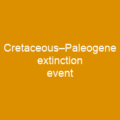The Permian-Triassic Extinction: A Cataclysmic Event
Imagine the Earth as it was 251.9 million years ago—rich with life but facing an unprecedented crisis. The Permian–Triassic extinction event, often referred to as ‘The Great Dying,’ stands as one of the most catastrophic events in our planet’s history, wiping out a staggering 70% of marine species and 57% of terrestrial vertebrate families. This cataclysmic event raises a profound question: What could have caused such devastation?
The Culprit: Flood Basalt Eruptions
One of the primary suspects in this environmental crime is the Siberian Traps, massive flood basalt eruptions that spewed vast amounts of sulfur dioxide and carbon dioxide into the atmosphere. These volcanic outpourings are estimated to have released up to 2,500 parts per million (ppm) of CO2, dramatically altering Earth’s climate and oceans.
A Web of Contributing Factors
While the Siberian Traps were a key player, other factors may have contributed to this mass extinction. Methane emissions from the seafloor, longer El Niño events, an extraterrestrial impact, or even the burning of oil and coal deposits ignited by volcanic activity are all potential suspects. Each one adds another layer to the complex puzzle of what led to such a profound ecological collapse.
The Timeline of Extinction
The Permian–Triassic extinction event didn’t happen overnight; it spanned approximately 60,000 years, with evidence suggesting multiple pulses or phases. The first pulse is believed to have occurred around 251.941 million years ago, followed by a second and possibly a third phase. This prolonged duration adds another layer of complexity to understanding the event’s impact.
Impact on Marine Life
The marine ecosystem bore the brunt of this extinction event. Over 80% of marine species vanished, with foraminifera, conodonts, and ammonoids among those hit hardest. The ‘Lilliput effect’ was observed in some survivors, where species became smaller after the extinction event. However, some groups like gastropods experienced a different fate, ballooning in size during this period.
Terrain and Terrestrial Life
Terrestrial life also suffered significant losses. Eight or nine insect orders became extinct, while the dominant flora of the time, Glossopteris, collapsed in Australia before the event. The recovery of terrestrial ecosystems took an unusually long 30 million years, with gymnosperms and lycophytes dominating early on.
Recovery and Resilience
The aftermath of this extinction saw a period of ecological restructuring. Terrestrial vertebrates like Lystrosaurus dominated some regions, while archosaurs eventually displaced therapsids during the mid-Triassic. The recovery was not uniform; different regions and ecosystems recovered at varying rates, with some areas showing more resilience than others.
The Ongoing Debate: Causes and Consequences
The causes of this mass extinction remain a subject of intense debate among scientists. While volcanic activity is the most widely accepted explanation, other theories such as an asteroid impact or methane release from the seafloor are also considered. The complexity of these factors underscores the intricate nature of Earth’s ecosystems and their vulnerability to sudden environmental changes.
The Permian–Triassic extinction event serves as a stark reminder of the potential consequences of rapid climate change and environmental disruption. As we face modern challenges like anthropogenic global warming, studying this ancient crisis provides valuable insights into how our planet can be profoundly affected by such events. The lessons from the past may hold the key to understanding and mitigating future crises.

You want to know more about Permian–Triassic extinction event?
This page is based on the article Permian–Triassic extinction event published in Wikipedia (retrieved on March 15, 2025) and was automatically summarized using artificial intelligence.






